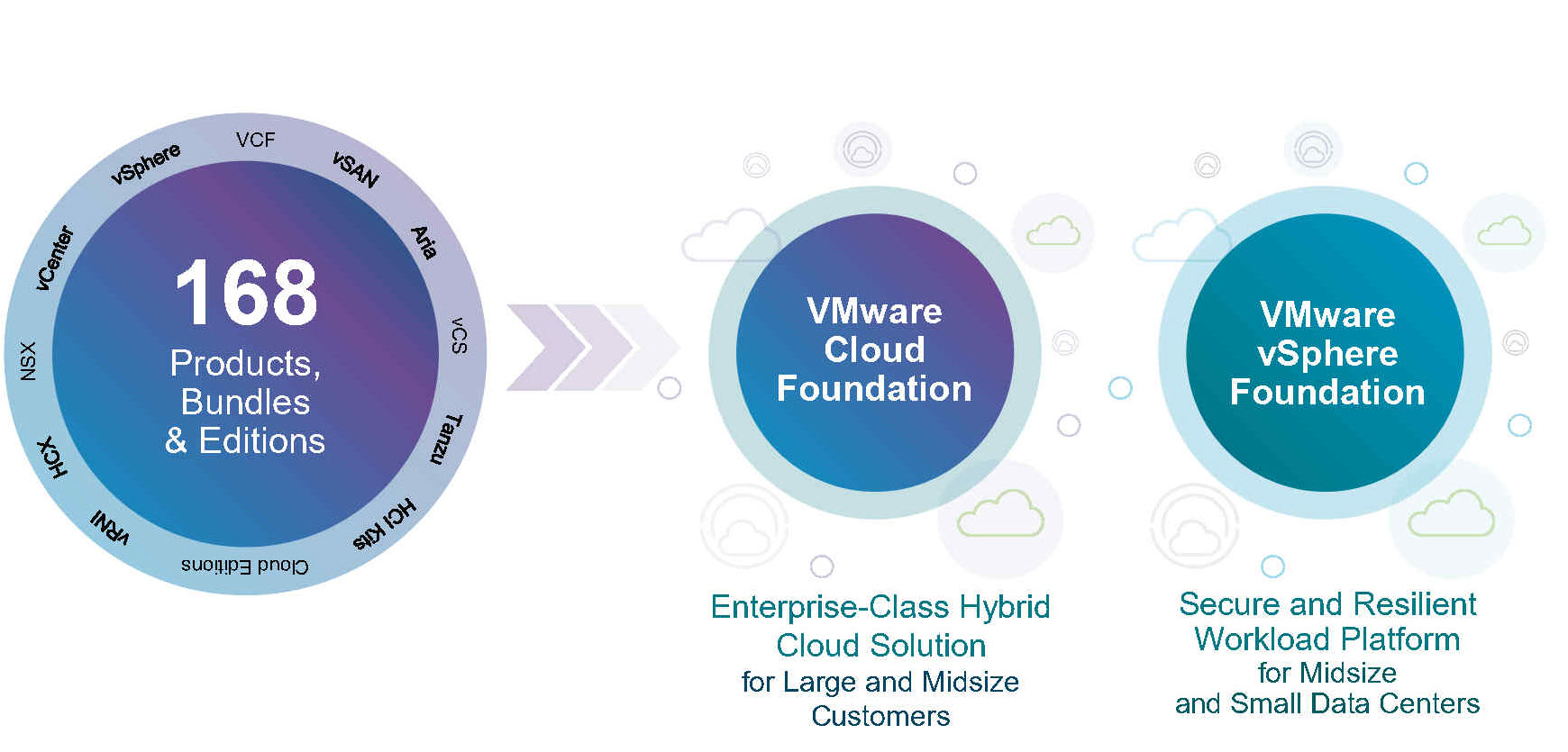 CLOUD
CLOUD
 CLOUD
CLOUD
 CLOUD
CLOUD
Vowing to simplify management of a collection of point products, Broadcom Inc. today announced updates to its VMware Cloud Foundation private cloud platform that integrate networking, storage and management functions more tightly.
The company also announced a new release of the vSphere hypervisor aimed at customers that want basic virtualization technology.
Cloud Foundation combines computing, networking, storage, management, and security across endpoints and includes the Kubernetes orchestrator for software containers as a native service. VCF customers recently gained license portability, enabling them to purchase subscriptions to the software and move them between on-premises and cloud environments without penalties.
Prashanth Shenoy, vice president of marketing for cloud platform, infrastructure and solutions at Broadcom’s VMware subsidiary, said the simplified licensing is part of a broader effort to standardize the company’s products on a subscription model and shouldn’t be seen as a price increase.
Charges that VMware is raising prices are “where you’ve heard the FUD [fear, uncertainty and doubt] in the market,” he said. “Nothing could be further from the truth. We cut the price by half for VCF and moved from a perpetual license model to a subscription-based model that is the standard that every infrastructure and software vendor has used for the last several years. VMware was one of the last to still do perpetual licensing.”
Broadcom is attempting to reduce the complexity of VMware’s vast portfolio (pictured), Shenoy said. “We have pivoted our strategy to make VCF the best available private cloud platform with a cloud operating model where customers can deploy network, storage, computer, automation and management as a single platform where they want,” he said.
Vsphere, vSAN storage virtualization, NSX networking and Aria cloud management “has become a patchwork for our customers,” Shenoy said. “As an independent company we had 168 products and bundles and over 9,000 SKUs. We made customers system integrators. Our job is to clean up the seams around these products and make them act like a single private cloud platform.”
As a unit of Broadcom, VMware has consolidated multiple divisions into a single organization under one general manager with integrated product, support and professional services, Shenoy said. “This makes us row in the same direction with everyone focused on delivering a single integrated product,” he said. “The whole idea is to make platform easier to build, scale and upgrade.”
VCF now provides full support for the vSAN Max scalable storage manager and vSAN Express Storage Architecture stretched clusters, providing petabyte-scale disaggregated storage and active-active availability. VCF Edge is a Cloud Foundation configuration for edge use cases with consistent management from data center to edge.
VCF 5.2 also features quick-start application deployment templates, easier network integration and advanced performance reports. Tanzu Kubernetes Grid is offered as an independent service with a release schedule that aligns with native Kubernetes and simpler updating.
Networking for VCF has been improved to simplify setup and configuration as users move from traditional virtual local area network-based set-ups to NSX virtualization. Enhancements to VCF networking will also enable VMware’s Avi Load Balancer to deliver self-service load balancing as a service.
“Flexible networking options include the ability to import VLAN-based networking during import or on Day N and deploy WLD with VCF networking,” Shenoy said. VMware Workload Domain is a concept within VMware’s software-defined data center architecture that represents a logical division of resources within an SDDC tailored to support specific types of workloads or applications.
New synchronization management features now sync out-of-band changes from VCF with the SDDC manager to allow full environment management from with SDDC. “It seamlessly synchronizes all of these elements and keeps them up-to-date,” Shenoy said. “The bottom line is reduced downtime and simplified upgrades and migration.”
Security updates include live patching of the ESXi bare metal hypervisor without the need for downtime or reboots. A VCF Component upgrade can be used to apply any patches available at the time of an upgrade to a new VCF version.
“ESXI live patching applies essential patches without taking hosts offline or evacuating VMs,” Shenoy said. “It supports bug fixes so the environment is operational and compliant with greatly reduced downtime.”
Dual data processing unit support with vSphere Distributed Services Engine supports redundant or fully independent DPUs to offload processing from CPUs and reduce the risk of failure. VSAN Data Protection recovers VMs from accidental deletions and ransomware attacks more easily.
VMware vDefend lateral security features increased distributed and gateway firewall scale, security information and event management integration for east-west ransomware protection and on- premises network detection and response. VMware Avi integration with SDDC Manager streamline lifecycle management of Avi software from deployment, through provisioning, to ongoing operations.
Updates in version 5.2 of VMware vSphere Foundation include ESXi live patching with zero downtime. There’s also access to self-service infrastructure via the vSphere IaaS control plane and a local consumption interface for infrastructure services. In addition, there’s an independent Tanzu Kubernetes Grid Service with asynchronous updates to the latest Kubernetes releases and a simplified console that includes global inventory, simplified diagnostics, centralized certificate management and unified licensing.
“For customers who just want a virtual compute environment, it helps boost operational efficiency, accelerates innovation for DevOps and platform engineers and elevates security because all the resident capabilities are built-in,” Shenoy said.
VMware Cloud Foundation 5.2 and VMware vSphere Foundation 5.2 are expected to be available in Broadcom’s fiscal third quarter, which ends in October.
THANK YOU